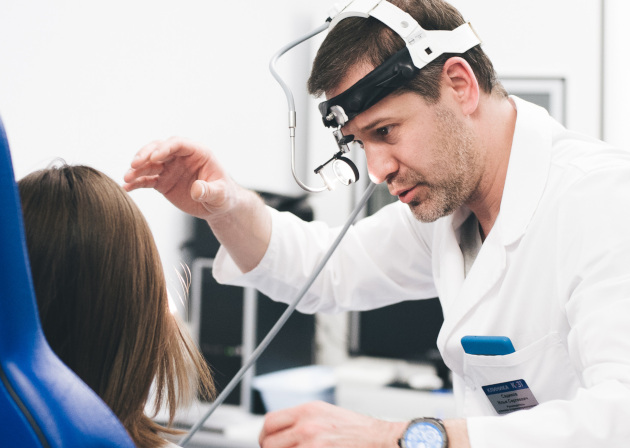Infundibulotomy

specialists

equipment

treatment
Показания к операции инфундибулотомии

Infundibulotomy has the following indications:
- Chronic sinusitis is an inflammatory process in the maxillary sinus resistant to drug treatment
- Polyps and cysts - block the nasal passages, causing a runny nose, decreased sense of smell, pain in the face, snoring
- Congenital or acquired anomalies in the structure of the infundibulum - prevent the normal outflow of secretions from the sinus
- Recurrent infections - frequent and prolonged rhinosinusitis disrupts the functioning of the sinuses
The operation is performed in the presence of foreign bodies in the maxillary sinus, which lead to chronic inflammation and accumulation of fluid in the sinus cavity. Intervention is also necessary for traumatic injuries resulting from dental procedures. They provoke inflammation of the sinuses and blockage of the nasal passages due to swelling of the mucous membrane.
Contraindications
The operation is not performed if there are absolute and relative restrictions.
Among the relative contraindications are age restrictions and pregnancy. In old age, there is a high probability of operational risks due to the presence of concomitant diseases. Doctors may postpone infundibulotomy for pregnant women until after delivery if this is possible without significant harm to the mother's health. Before starting surgical treatment, a thorough examination of the patient is necessary. The doctor issues referrals for a general blood test, coagulogram, CT or MRI. Laboratory and instrumental research methods help determine the presence of contraindications and minimize the risk of complications.

Absolute contraindications:
- Acute infectious diseases The presence of an active inflammatory process, for example, acute sinusitis, increases the likelihood of infectious complications.
- Bleeding disorders Coagulopathies or taking anticoagulants provoke bleeding.
- Systemic diseases in the acute stage Uncontrolled diabetes mellitus and severe cardiovascular disease increase the risk of complications during and after surgery.
- Oncological diseases The presence of malignant neoplasms in the nose and sinuses requires chemotherapy or radiotherapy.
- Allergic reactions to anesthesia Intolerance to the anesthetic drug makes the intervention unsafe.
- Complex anatomical features Extensive adhesions or severe deformities make the operation difficult.
- Insufficient access If the nasal passages are too narrow, the doctor selects another surgical method.
Answers to popular questions
When is endoscopic removal of the uncinate process necessary?
How effective is the procedure?
What complications occur after infundibulotomy?
Are there alternatives to infundibulotomy?
Can infundibulotomy help with allergic rhinitis?

How is an appointment with an otolaryngologist at K+31?
Our doctors

This award is given to clinics with the highest ratings according to user ratings, a large number of requests from this site, and in the absence of critical violations.

This award is given to clinics with the highest ratings according to user ratings. It means that the place is known, loved, and definitely worth visiting.

The ProDoctors portal collected 500 thousand reviews, compiled a rating of doctors based on them and awarded the best. We are proud that our doctors are among those awarded.
Make an appointment at a convenient time on the nearest date
Price












































Who is an ENT surgeon?